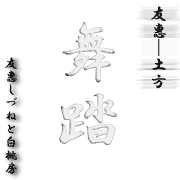| | It was also at this phase that separate group styles began to develop. Butoh dancers studied how the body, time, and space should be in the context of the Japanese life style, as well as through the techniques of traditional Japanese performing arts: Kabuki mie (striking a pose), Noh hakobi (sliding walk), and ningyou - buri (puppet - style movement and gestures) from the puppet Narrative Theatre. The findings were digested and incorporated into Butoh as artistic elements of its stage performance.
The Body of Butoh:
I call the task usually referred to as choreography tofuri. It is a coined term, yet to be translated in other languages. Tofuri has to be fundamentally different from usual choreography, which can be reduced into from and movement.
In portraying a tree, for instance, we do not emphasize a visual approach. We consider it more important to incorporate into our performance the flow of energy as the tree absorbs nutrition through its roots, constantly sending it from the trunk to the branches and to the leaves. We emphasize the organic mechanism of nature itself. At the same time we need to look at a tree in the way that Saint Myoe(1173-1232), a Japanese Buddhist monk, did. He said: “It is all because of its Buddha nature that a tree stands there, grows leaves on it, and lets flowers bloom.モ While we consider the tactile of texture important, we believe we will be able to cope with the body, which is in a way a mixture of material and spirit. And we also believe that, through such a body, we are able to live the question of life and death.
|
writing : TOMOE SHIZUNE | | (An extract from program of "TOMOE SHIZUNE & HAKUTOBO" invited by "the Edinburgh International Festival'96")
The avant-garde arts movement in 1960's was led mostly by musicians and visual artists. In midst of it, an avant-garde dance called Butoh was quickly making its existence known. With HIJIKATA Tatsumi (modern dancer) as its leader, the Butoh movement at this phase was quite aggressive and full of experiments, involving not only dancers but actors and show dancers as well. They would dance half-naked with plaster-like white makeup applied to their body; some mail dancers would dance in female attire. Collaborations with avant-garde jazz groups were also among such experiments.
In 1970's, the painted white face and body became standardized, and the dancers advocated the theory of the physique with the Japanese body as their point of reference. | | 
Copyright (c) OFFICE TOMOE Ltd.1995 All Rights Reserved. | |

